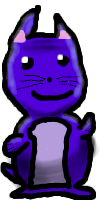In today’s tutorial we’re going to look at a method I use for creating an exploding sprite effect!
This is useful when, well, you need to blow things up! In my experience this happens a lot in game development.
First things first, you’re going to need a few assets…
- A character to move around.
- An explosion animation.
- Something to detonate when the character collides with it.
If you don’t have these things handy, here are some assets you can use:
Character:

Explosion animation (frameWidth: 64, frameHeight: 64):

Something to detonate (frameWidth: 32, frameHeight: 32):

So first for our code, we’ll want to preload our assets and create our animations in the BootScene:
import {Scene} from 'phaser';
class BootScene extends Scene {
constructor() {
super("scene-boot");
}
preload() {
this.load.image('cat-like', 'assets/cat-like-creature.png');
this.load.spritesheet('bomb', 'assets/bomb.png', {
frameWidth: 32,
frameHeight: 32
});
this.load.spritesheet('kaboom', 'assets/kaboom.png', {
frameWidth: 64,
frameHeight: 64
});
}
create() {
this.anims.create({
key: 'bomb-idle',
frames: this.anims.generateFrameNumbers('bomb', {
start: 0,
end: 3
}),
repeat: -1,
frameRate: 14
});
this.anims.create({
key: 'kaboom-boom',
frames: this.anims.generateFrameNumbers('kaboom', {
start: 0,
end: 7
}),
repeat: 0,
frameRate: 16
});
this.scene.start('scene-game');
}
}
export default BootScene;
If you’ve worked with Phaser preloading and regular spritesheet animation before, this code will look pretty familiar to you.\
In the preload() function we’re loading in an image, and two spritesheets for our character, explosion and bomb sprites.
In the create() function, we’re creating two animations for the idle bomb, and the explosion.
Next is where things get interesting, we’ll create our GameScene, wherein we’ll implement the explosion detonation logic:
import {Scene, Math as pMath} from 'phaser';
class GameScene extends Scene {
constructor() {
super("scene-game");
}
create() {
// Pretty background colour
this.cameras.main.setBackgroundColor(0x00FF55);
// Add our character
this.cat = this.physics.add.sprite(10, 10, 'cat-like');
this.cat.setScale(0.5);
this.catSpeed = 300;
// Create our explosion sprite and hide it initially
this.boom = this.physics.add.sprite(100, 100, 'kaboom');
this.boom.setScale(3);
this.boom.setVisible(false);
// Set it to hide when the explosion finishes
this.boom.on('animationcomplete', () => {
this.boom.setVisible(false);
})
// Create a group for our bombs
this.bombs = this.add.group();
// Randomly position 10 bombs
for (let i = 0; i <= 9; i++) {
const rx = pMath.Between(100, window.innerWidth);
const ry = pMath.Between(100, window.innerHeight);
const bomb = this.physics.add.sprite(rx, ry, 'bomb');
bomb.setScale(2);
bomb.play('bomb-idle');
// Create overlaps with our character and each bomb
this.physics.add.overlap(this.cat, bomb, this.detonate, null, this);
this.bombs.add(bomb);
}
// Set a toggle for when the a bomb has exploded
this.exploded = false;
// Create cursor keys
this.cursors = this.input.keyboard.createCursorKeys();
}
// Our function to detonate a bomb on touch
detonate(cat, bomb) {
// Only detonate once
if (!this.exploded) {
// Get the x and y of the bomb we touched
const {x, y} = bomb;
// Hide the character and the bomb
cat.setVisible(false);
bomb.setVisible(false);
// Position the explosion where the bomb was and play it
this.boom.setPosition(x, y);
this.boom.setVisible(true);
this.boom.play('kaboom-boom');
// Flip our toggle
this.exploded = true;
}
}
update() {
const {left, right, up, down} = this.cursors;
// Only allow movement if we haven't yet touched a bomb
if (!this.exploded) {
if (left.isDown) {
this.cat.setVelocityX(-this.catSpeed);
}
else if (right.isDown) {
this.cat.setVelocityX(this.catSpeed);
}
else {
this.cat.setVelocityX(0);
}
if (up.isDown) {
this.cat.setVelocityY(-this.catSpeed);
}
else if (down.isDown) {
this.cat.setVelocityY(this.catSpeed);
}
else {
this.cat.setVelocityY(0);
}
}
// If we have, freeze our movement
else {
this.cat.setVelocity(0);
}
}
}
export default GameScene;
The method used her is pretty straightforward. We create a bunch of bomb instances on the screen, and add a physics.overlap() for each of them to detect hittests between bombs and our cat character. For more on hittests in Phaser 3, see this tutorial.
When an overlap is detected, we hide the bomb and cat sprites, and show an explosion where the bomb was.
We play the explosion animation, and listen for when the animation is complete, then reset the visibility of the explosion to hidden.
So that’s my method for blowing up sprites in Phaser. It can totally be improved upon, and if you have ideas on how to do that feel free to Tweet at me – @saricden!
As always, happy hacking!
Love Kirk M. (@saricden)
